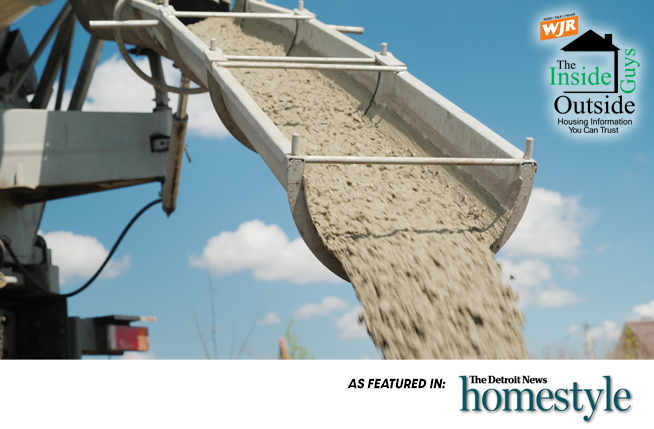
By Ken Calverley and Chuck Breidenstein
DETROIT, October 28, 2021 ~ The Guys receive several thousand emails each year from listeners with housing questions.
Though we respond to each of them individually, they often follow seasonal themes that apply to many of us.
Going into the autumn months, we tend to get a lot of questions about exterior concrete like those shown here.
Q. Is fall a good time to have my new concrete driveway installed?
A. The cooler fall months are an excellent time to place concrete. If you don’t pour onto frozen ground and the placement is protected from freezing for three days, you will get a better cure in the cooler, humid air.
Concrete will actually get stronger when it can cure slowly and in a damp environment.
Q. I’ve heard that you should put some kind of sealer on concrete to protect it.
A. Residential concrete is usually quite porous and readily absorbs anything spilled or dripped onto its surface. This includes the road salts from your vehicles during the winter months. Salts will carry water deeper into your concrete.
We all know that when water freezes it expands and this expansion destroys your wet concrete. Preventing the water from getting into the concrete is step one.
There are many water-based sealing products that can be applied with a paint roller in the fall. For exterior concrete you want to apply a breathable sealer that allows any water already in the concrete to escape.
Q. What do I do with the joints in my concrete slabs?
A. Most of the joints in exterior concrete are what we call control joints. They exist to control the inevitable cracking in an acceptable manner. Those next to the house are isolation joints intended to keep the concrete from bonding with the foundation. These joints allow water to get beneath the concrete where it can undermine base materials and freeze. We know this freezing can cause uplift and damage to the slabs.
The Guys suggest that all of these should be filled with a quality material like a “liquid” caulk. Sika-Flex is one such caulk. For the larger joints, either dry sand or closed cell foam “rod backers” are used to close the joint before application of either a liquid caulk or a troweled material.
Q. I am getting a new concrete drive and sidewalk installed. Are there any concerns or questions I should express when dealing with the contractor?
A. Great question! You want to place a minimum 4000PSI concrete at a low slump, (think “less water”). This helps to assure proper strength. You want a copy of the job ticket from the ready-mix truck for your records. It will indicate the strength of the mix, any additives including extra water, and the time it was mixed and placed. All can impact durability.
You want a nominal 4” deep pour on 4- 6” of well compacted base like crushed concrete. A 6 by 6 steel mesh should be installed at the center of the depth.
There should be enough crew to quickly place and finish the slab without adding water or moving it around too much. The concrete should be floated, then troweled when ready prior to any surface textures being applied.
Proper troweling brings a cement paste to the top of the mix and helps to seal the surface.
The concrete should also be placed such that the surface is well above any surrounding grade, and it will readily shed water from all surface points.
It is also important to note, with all the wet weather we’ve had, concrete should not be placed into standing water. It will undermine and dilute the mix.
Depending on weather and other factors, control joints should be cut within 24-48 hours of placement.
Q. My 30-year-old concrete is in great shape except for the surface. It is all chipped and rough. Do I have to replace it?
A. Not anymore! For years people have been frustrated with the poor performance of epoxies and cement-based laminates that are supposed to restore concrete surfaces. They generally do not work over time.
Motor City Floors and Coatings in Novi and TruTech in Brighton have a coating they warranty for 15 years that chemically binds to the concrete and can be installed in various colors, patterns and with customized logos.
It provides a beautiful finish and is less expensive than replacement.
Q. My garage concrete slabs have separated and seem to be sinking. Can it be saved?
A. Yes. In most cases, large slabs that lose their base can be “mud-jacked” back into place.
You will usually choose between a foam product that is a little pricier and a concrete slurry. Both can be effectively utilized to lift sunken slabs back into place.
The Guys appreciate all the questions we receive and take great pains to provide information and resources you can trust. As always, you can find great contractors for all these services at InsideOutsideGuys.com.





